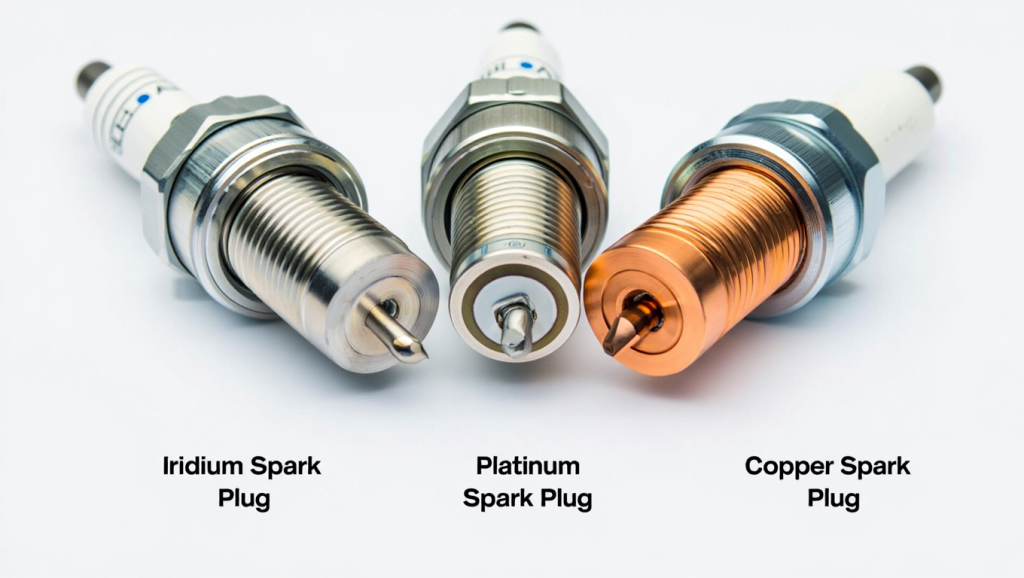Choosing the wrong plug can lead to misfires, poor fuel economy, increased emissions, or even engine damage over time.
Spark plugs may look small, but they are the heartbeat of your engine. And the type of spark plug—copper, platinum, or iridium—directly affects longevity, performance, and overall engine health.
In this guide, I’ll explain the differences between copper, platinum, and iridium spark plugs, their best applications, cost, lifespan, and more.
Understanding Spark Plugs and Their Role
How Spark Plugs Work
A spark plug’s main job is to generate a tiny, controlled spark across a gap between its center and ground electrodes. This spark ignites the compressed air-fuel mixture inside the combustion chamber, producing the explosion that moves pistons.
Modern engines operate at thousands of combustion cycles per minute. Each spark plug must endure:
- Extreme heat: up to 1,200°F in the combustion chamber.
- High pressure: hundreds of pounds per square inch in the cylinder.
- Constant vibration: from engine movement and torque.
The quality of the spark is influenced by:
- Electrode material.
- Spark gap width.
- Heat range of the plug.
A plug that’s worn or made from the wrong material can misfire, reduce fuel efficiency, or damage ignition coils.
Why Plug Material Matters
The electrode material determines:
- Durability: How long the spark plug maintains its shape and gap.
- Electrical conductivity: Copper conducts electricity best but wears fastest; iridium lasts longest with precise sparks.
- Performance: Ensures consistent ignition and smooth engine operation.
Using the correct material for your engine ensures reliability, efficiency, and protects your ignition system.
1. Copper Spark Plugs

Construction and Features
Copper spark plugs have a copper core surrounded by a nickel alloy electrode. Copper is extremely conductive, providing a strong spark even at low voltages. However, copper wears faster than platinum or iridium, so these plugs need frequent replacement.
Key specs:
- Electrode type: nickel-alloy with copper core.
- Lifespan: 20,000–30,000 miles.
- Performance: excellent initial spark.
Best Applications
Copper plugs are ideal for:
- Older vehicles with traditional ignition systems.
- High-performance engines requiring strong spark under high load.
- Turbocharged or naturally aspirated engines that demand peak combustion energy.
Example: A 2005 Mustang GT with copper plugs requires replacements every 20,000 miles, but provides excellent throttle response and acceleration.
Pros and Cons
Pros:
- Excellent electrical conductivity.
- Low cost ($2–$5 per plug).
- Strong spark performance.
Cons:
- Short lifespan; frequent replacement required.
- Not ideal for modern coil-on-plug systems.
- May cause fouling in low-heat engines.
2. Platinum Spark Plugs

Construction and Features
Platinum spark plugs use a platinum tip on the center electrode. This hard metal resists wear, providing longer life than copper. Conductivity is slightly lower, but the trade-off is longer intervals between replacements and stable performance.
Key specs:
- Electrode tip: platinum.
- Lifespan: 50,000–60,000 miles.
- Performance: reliable spark with moderate conductivity.
Best Applications
Platinum plugs are perfect for:
- Modern coil-on-plug engines.
- Daily drivers needing maintenance-free operation.
- Vehicles where long-term reliability and moderate cost are priorities.
Example: A 2015 Toyota Camry with platinum plugs can run 60,000 miles with consistent fuel efficiency and smooth idle, with minimal replacement cost over the vehicle’s life.
Pros and Cons
Pros:
- Long-lasting, stable performance.
- Moderate cost ($8–$15 per plug).
- Resistant to electrode erosion.
Cons:
- Slightly lower spark intensity than copper.
- Not designed for extreme performance engines.
3. Iridium Spark Plugs

Construction and Features
Iridium spark plugs have ultra-fine iridium tips on the center electrode, one of the hardest metals used in spark plugs. This allows a very small, precise spark gap, increasing combustion efficiency. Iridium plugs are extremely durable, offering the longest life of the three types.
Key specs:
- Electrode tip: iridium.
- Lifespan: 80,000–120,000 miles.
- Performance: precise spark, excellent cold-start reliability.
Best Applications
Iridium plugs excel in:
- Modern engines with high-tech ignition systems.
- Vehicles prioritizing fuel economy and emissions.
- High-mileage engines where long-term reliability is essential.
Example: A 2020 Honda Accord with iridium plugs can run 100,000 miles without replacement, maintaining OEM-level fuel efficiency, smooth idle, and reliable ignition.
Pros and Cons
Pros:
- Longest lifespan.
- Strong, consistent spark for optimal combustion.
- Excellent for cold starts and fuel efficiency.
Cons:
- High cost ($15–$25 per plug).
- Overkill for older, simple engines.
5 warning signs your spark plugs need replacement

Head-to-Head Comparison: Copper vs Platinum vs Iridium

| Feature | Copper | Platinum | Iridium |
| Lifespan | 20k–30k mi | 50k–60k mi | 80k–120k mi |
| Conductivity | Excellent | Good | Very Good (small gap) |
| Cost | $2–$5 | $8–$15 | $15–$25 |
| Performance | Strong spark | Balanced | Optimal spark & efficiency |
| Best Use | Older & high-performance engines | Daily drivers | Modern engines & long-life |
| OEM vs Aftermarket | Available | Available | Available from trusted brands |
Summary: Copper is cost-effective with peak spark; platinum balances cost and longevity; iridium maximizes durability, efficiency, and reliability.
OEM vs Aftermarket Spark Plugs
- OEM: Matches factory specs, heat range, and gap; ensures warranty compliance.
- Aftermarket: Can perform equally well if from trusted brands like NGK, Bosch, or Denso.
- Tip: Only upgrade materials if your vehicle supports it. Iridium is ideal for modern engines, while older engines may benefit more from copper’s high conductivity.
Technical Insights: Heat Range and Spark Gap
Understanding Heat Range
The heat range of a spark plug controls its ability to dissipate heat from the tip.
- Too hot: Causes pre-ignition and engine knocking.
- Too cold: Leads to carbon buildup and fouling.
Copper plugs conduct heat well but have narrow heat ranges; platinum and iridium can handle a wider range, making them better for high-mileage engines and modern ignition systems.
Gap Adjustment
Even pre-gapped plugs can drift during shipping. Proper gap ensures optimal spark and combustion. Using a feeler gauge to set the exact gap is critical for all three plug types.
Common Mistakes When Choosing Spark Plugs
- Installing the wrong heat range → misfires or pre-ignition.
- Mixing different types in one engine → uneven performance.
- Over-tightening or cross-threading → cylinder head damage.
- Assuming “expensive = best” → copper may outperform in high-demand older engines.
- Neglecting gap adjustments → inefficient combustion, rough idle.
Practical Pro Tips for Spark Plug Replacement
- Replace plugs as a full set, never individually.
- Always check the gap with a feeler gauge.
- Inspect ignition coils and wires.
- Use anti-seize sparingly, only if manufacturer recommends.
- Follow OEM torque specifications to prevent stripped threads.
- Keep mileage and replacement records to maintain performance.
Real-World Cost Comparison
| Type | DIY Cost | Dealer Cost |
| Copper | $2–$5 | $10–$20 |
| Platinum | $8–$15 | $20–$35 |
| Iridium | $15–$25 | $35–$50 |
Replacing spark plugs proactively is inexpensive compared to ignition coil or engine repairs caused by misfires.
Conclusion
Choosing the right spark plug is essential for engine health. Copper delivers a strong spark at low cost but wears fast. Platinum balances performance and longevity. Iridium provides maximum durability, efficiency, and reliability.
Regular inspection and replacement prevent misfires, poor fuel economy, and engine damage. Always follow the manufacturer’s recommendation and choose OEM or trusted aftermarket plugs.
FAQs
How often should spark plugs be replaced?
Copper: 20k–30k miles, platinum: 50k–60k miles, iridium: 80k–120k miles. Driving conditions like towing, city stop-and-go, or dusty roads may require earlier replacement. Following the owner’s manual ensures smooth engine operation, fuel efficiency, and longevity while avoiding misfires and premature ignition system wear.
Can I switch from copper to iridium or platinum?
Yes, if your vehicle supports it. Modern engines benefit from iridium for longer life and consistent combustion. Platinum is also acceptable for most daily drivers. Always follow the manufacturer’s heat range recommendations. Improper switches can reduce performance, cause misfires, or damage ignition components.
Do iridium plugs improve fuel economy?
Iridium plugs provide precise sparks, optimizing combustion. Gains are modest—typically 1–3%—but consistent efficiency lasts longer than copper or platinum, especially in high-mileage engines. Improved spark reduces unburned fuel, lowers emissions, and maintains manufacturer-rated MPG over the plug’s long lifespan.
What happens if I use the wrong spark plug?
Incorrect plugs may cause misfires, rough idle, poor acceleration, increased emissions, and damage to ignition coils or cylinder heads. Too-hot
plugs can pre-ignite fuel, while too-cold plugs can foul. Using the correct material, heat range, and gap is critical to prevent costly engine repairs.
Are OEM spark plugs better than aftermarket ones?
OEM plugs are guaranteed to meet manufacturer specifications for fit, heat range, and performance. Trusted aftermarket brands (NGK, Bosch, Denso) can perform equally well. Low-quality plugs may wear faster or misfit. OEM or high-quality aftermarket options are recommended for reliability and warranty compliance.
Do performance spark plugs add horsepower?
Performance plugs may slightly improve combustion, adding 1–3 horsepower by reducing misfires and maintaining optimal spark. Gains are most noticeable under load or in high-performance engines. They also improve throttle response, cold-start reliability, and fuel efficiency but won’t dramatically increase power in stock vehicles.

Benjamin Grey is an automotive engineer and writer at Car Parts Advisor. With years of experience in the automotive industry, he shares expert advice on car parts, maintenance, and repairs to help car owners keep their vehicles running smoothly.





